WASHINGTON (AFP) – The world’s 26 poorest economies are facing the most significant debt burden since 2006, the World Bank announced in a new report published on Sunday.
Government debt in these countries, which are home to around 40 per cent of the world’s population, now stands at an average of 72 per cent of gross domestic product (GDP) – an 18-year high – the Washington-based development lender said.
At the same time, the amount of international aid they receive as a share of their economic output has shrunk to a two-decade low.
“There is much that low-income economies can – and must – do for themselves,” the World Bank’s deputy chief economist Ayhan Kose said in a statement. “But these economies also need stronger help from abroad.”
Low-income economies borrowed heavily during the COVID-19 pandemic, causing primary deficits to triple, the bank said, adding that many countries had been unable to “fully unwind” these deficits.
Nearly half of the world’s 26 poorest economies now find themselves in debt distress or at high risk of it – double the figure it was in 2015.
The World Bank said its concessional lending arm, the International Development Association (IDA), had provided “nearly half” of all the development aid these economies received in 2022 from multilateral organisations.
“At a time when much of the world simply backed away from the poorest countries, IDA has been their main lifeline,” the bank’s chief economist Indermit Gill said.
“But if they are to rise out of a state of chronic emergency and meet key development goals, low-income economies will need to accelerate investment to a pace without precedent,” he added.





